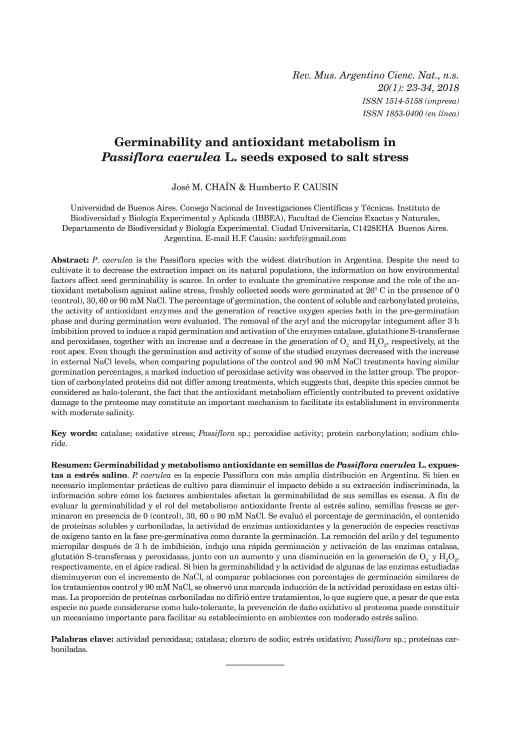Artículo
P. caerulea es la especie Passiflora con más amplia distribución en Argentina. Si bien es necesario implementar prácticas de cultivo para disminuir el impacto debido a su extracción indiscriminada, la información sobre cómo los factores ambientales afectan la germinabilidad de sus semillas es escasa. A fin de evaluar la germinabilidad y el rol del metabolismo antioxidante frente al estrés salino, semillas frescas se germinaron en presencia de 0 (control), 30, 60 o 90 mM NaCl. Se evaluó el porcentaje de germinación, el contenido de proteínas solubles y carboniladas, la actividad de enzimas antioxidantes y la generación de especies reactivas de oxígeno tanto en la fase pre-germinativa como durante la germinación. La remoción del arilo y del tegumento micropilar después de 3 h de imbibición, indujo una rápida germinación y activación de las enzimas catalasa, glutatión S-transferasa y peroxidasas, junto con un aumento y una disminución en la generación de O2 - y H2 O2 , respectivamente, en el ápice radical. Si bien la germinabilidad y la actividad de algunas de las enzimas estudiadas disminuyeron con el incremento de NaCl, al comparar poblaciones con porcentajes de germinación similares de los tratamientos control y 90 mM NaCl, se observó una marcada inducción de la actividad peroxidasa en estas últimas. La proporción de proteínas carboniladas no difirió entre tratamientos, lo que sugiere que, a pesar de que esta especie no puede considerarse como halo-tolerante, la prevención de daño oxidativo al proteoma puede constituir un mecanismo importante para facilitar su establecimiento en ambientes con moderado estrés salino. P. caerulea is the Passiflora species with the widest distribution in Argentina. Despite the need to cultivate it to decrease the extraction impact on its natural populations, the information on how environmental factors affect seed germinability is scarce. In order to evaluate the greminative response and the role of the antioxidant metabolism against saline stress, freshly collected seeds were germinated at 26° C in the presence of 0 (control), 30, 60 or 90 mM NaCl. The percentage of germination, the content of soluble and carbonylated proteins, the activity of antioxidant enzymes and the generation of reactive oxygen species both in the pre-germination phase and during germination were evaluated. The removal of the aryl and the micropylar integument after 3 h imbibition proved to induce a rapid germination and activation of the enzymes catalase, glutathione S-transferase and peroxidases, together with an increase and a decrease in the generation of O2 - and H2 O2 , respectively, at the root apex. Even though the germination and activity of some of the studied enzymes decreased with the increase in external NaCl levels, when comparing populations of the control and 90 mM NaCl treatments having similar germination percentages, a marked induction of peroxidase activity was observed in the latter group. The proportion of carbonylated proteins did not differ among treatments, which suggests that, despite this species cannot be considered as halo-tolerant, the fact that the antioxidant metabolism efficiently contributed to prevent oxidative damage to the proteome may constitute an important mechanism to facilitate its establishment in environments with moderate salinity.
Germinability and antioxidant metabolism in Passiflora caerulea L. seeds exposed to salt stress
Título:
Germinabilidad y metabolismo antioxidante en semillas de Passiflora caerulea L. expuestas a estrés salino
Fecha de publicación:
06/2018
Editorial:
Museo Argentino de Ciencias Naturales Bernardino Rivadavia
Revista:
Revista del Museo Argentino de Ciencias Naturales
ISSN:
1514-5158
e-ISSN:
1853-0400
Idioma:
Inglés
Tipo de recurso:
Artículo publicado
Clasificación temática:
Resumen
Archivos asociados
Licencia
Identificadores
Colecciones
Articulos(IBBEA)
Articulos de INSTITUTO DE BIODIVERSIDAD Y BIOLOGIA EXPERIMENTAL Y APLICADA
Articulos de INSTITUTO DE BIODIVERSIDAD Y BIOLOGIA EXPERIMENTAL Y APLICADA
Citación
Chaín, José María; Causin, Humberto Fabio; Germinability and antioxidant metabolism in Passiflora caerulea L. seeds exposed to salt stress; Museo Argentino de Ciencias Naturales Bernardino Rivadavia; Revista del Museo Argentino de Ciencias Naturales; 20; 1; 6-2018; 23-34
Compartir




